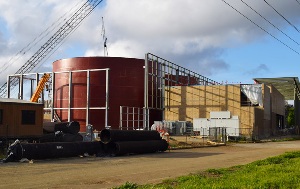Mar 29 2014
Normally, drought is a bad thing – except when it accelerates construction that has sometimes proven disruptive to the Stanford community.
 When it goes online, the Central Energy Facility will use an innovative heat-recovery process that is 70 percent more efficient than the existing steam process. Credit: Kate Chesley
When it goes online, the Central Energy Facility will use an innovative heat-recovery process that is 70 percent more efficient than the existing steam process. Credit: Kate Chesley
Thanks to favorable weather, the Stanford Energy System Innovations (SESI) installation of 20 miles of underground pipes is now about 85 percent complete. The entire installation should be finished by the end of the summer, according to Laura Goldstein, director of project management in Lands, Buildings & Real Estate (LBRE).
That's the good news for campus commuters and pedestrians, who have been dodging ditches and detours in areas ranging from Campus Drive to Escondido Road, and many places in between.
The bad news is that the largest section of the installation – from Welch Road down Oak Road – is still underway. That section, which could take as long as nine months to complete, will serve the new hospital facilities, making it a substantial installment.
Massive project
SESI's piping installation is part of a massive project – on target for its $485 million price tag – that will reduce Stanford's carbon emissions by 50 percent and save $300 million over the next 35 years. Perhaps more importantly, given current water conservation needs, the project will reduce campus water use by an estimated 15 percent.
Since 2000, Stanford has already reduced by 21 percent its domestic water use, through building retrofits and other conservation efforts. With the completion of SESI, Stanford's water reduction will increase to 36 percent in just 15 years – a substantial savings that will likely exceed projected targets for organizations and municipalities throughout California.
When fully implemented in 2015, SESI will result in one of the most energy-efficient systems in the world, replacing the natural-gas-fired cogeneration system used since 1987 for virtually all campus energy needs.
Cardinal Cogeneration, which is located on Campus Drive and is nearing the end of its useful life, produces electricity and then recovers and reuses waste heat from the combustion process. But the system discards valuable heat generated by cooling processes. Unlike cogeneration, the new Central Energy Facility (CEF) taking shape on Oak Road takes advantage of Stanford's temperate climate. Because of that climate and because research facilities make continuous use of refrigeration, university buildings are being cooled and heated at the same time. The new system achieves efficiency by taking advantage of this overlap, capturing waste heat from the chilling system to produce hot water for the heating system.
The new energy system is also designed to be flexible, allowing Stanford to take advantage of a variety of energy options – including buying energy from the grid.
SESI includes four major ongoing construction components:
- Installation of 20 miles of new underground piping to allow for the conversion to a hot water energy system.
- Construction of the new CEF, which will use an innovative heat-recovery process that is 70 percent more efficient than the existing steam process.
- A new electrical substation, located next to the CEF.
- Conversion of 155 buildings to receive hot water instead of steam.
Progress report
Goldstein said the new electrical substation is about 95 percent complete. LBRE hopes to begin energizing the substation at the end of this month. The new substation will allow the decommissioning of a substation now located off Panama Street and will add capacity for the future.
The CEF is about 70 percent complete and on schedule. At the end of the month, Goldstein hopes workers can begin filling the giant, red water tanks visible from throughout the west side of campus. Goldstein said the facility is on schedule to open March 2015.
The slow process of switching converted buildings to the new hot water system has already begun, thanks to small, temporary heat-exchange stations located throughout campus.
For instance, one temporary station is located behind Memorial Auditorium, which has already been converted to the hot water system. That temporary station is allowing LBRE to test how Memorial Auditorium and several other buildings are now performing.
Building conversions
The last piece of the construction puzzle involves the building-level conversion of 155 facilities to receive hot water instead of steam. That process is only about 20 percent finished because most building conversions require new SESI piping.
"Each building has a varying amount of impact. Some of the conversions are a short one or two weeks of work," Goldstein said. Some, however, are more intensive.
Buildings that feature steam radiators, including many on the Main Quadrangle, are more challenging to convert. Building occupants may experience some inconvenience due to the noise of construction or temperature variations as work progresses.
"One of the things we found at MemAud, for instance, is that we had not sized the new heat load for comfort. So people were initially cold," she said. "It's very important to us that we disrupt faculty, staff and students as little as possible."
So far, the new system is performing well.
"We expect that it will take us a couple of years to reach maximum efficiency," Goldstein said. "But, for now, things are going very well."